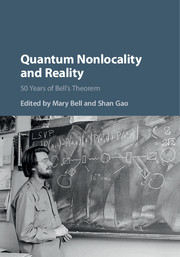Book contents
- Frontmatter
- Contents
- Contributors
- Preface
- Preface
- Part I John Stewart Bell: The Physicist
- Part II Bell's Theorem
- 4 What Did Bell Really Prove?
- 5 The Assumptions of Bell's Proof
- 6 Bell on Bell's Theorem: The Changing Face of Nonlocality
- 7 Experimental Tests of Bell Inequalities
- 8 Bell's Theorem without Inequalities: On the Inception and Scope of the GHZ Theorem
- Part III Nonlocality: Illusion or Reality?
- Part IV Nonlocal Realistic Theories
- Index
- References
4 - What Did Bell Really Prove?
from Part II - Bell's Theorem
Published online by Cambridge University Press: 05 September 2016
- Frontmatter
- Contents
- Contributors
- Preface
- Preface
- Part I John Stewart Bell: The Physicist
- Part II Bell's Theorem
- 4 What Did Bell Really Prove?
- 5 The Assumptions of Bell's Proof
- 6 Bell on Bell's Theorem: The Changing Face of Nonlocality
- 7 Experimental Tests of Bell Inequalities
- 8 Bell's Theorem without Inequalities: On the Inception and Scope of the GHZ Theorem
- Part III Nonlocality: Illusion or Reality?
- Part IV Nonlocal Realistic Theories
- Index
- References
- Type
- Chapter
- Information
- Quantum Nonlocality and Reality50 Years of Bell's Theorem, pp. 49 - 78Publisher: Cambridge University PressPrint publication year: 2016
References
- 2
- Cited by



